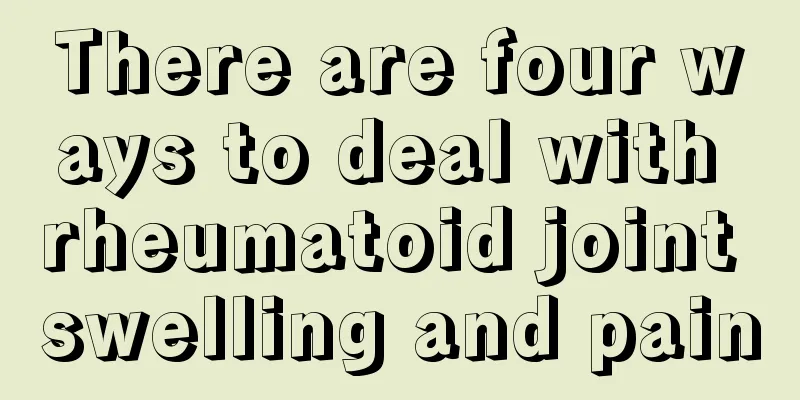There are four ways to deal with rheumatoid joint swelling and pain

|
Patients with rheumatoid arthritis often experience swollen and painful joints in daily life, but most people do not know much about how to relieve the swelling and pain of rheumatoid arthritis. In fact, there are four ways to relieve rheumatoid joint swelling and pain. The first and most important thing is to keep away from cold and dampness. 1. How to relieve the swelling and pain of rheumatoid arthritis 1. Prevent cold and dampness, and prevent colds. Rheumatoid arthritis is known as meteorological joints. Most patients are sensitive to climate changes. Joint swelling and pain will be aggravated on cloudy, rainy, cold, humid days, especially when there is frostbite, which often makes the patients who are in a stable period of treatment lose all their previous efforts. Therefore, we must pay attention to the impact of climate change on this disease and take precautions in advance. 2. Combine static and dynamic movements, and pay attention to proper exercise to help joint recovery 3. Regulate your emotions. Good emotions are the basis and prerequisite for treating diseases. The quality of emotions can directly affect the prognosis of the disease. Keep a calm mind, adhere to regular treatment, and have a reasonable expectation for the prognosis, which will help improve the condition. 4. Eat a reasonable diet and pay attention to the choices. As mentioned above, eat a balanced diet and do not avoid certain foods. If you find any allergic food, you should stop eating it in time and do not eat it again in the future. 2. What are the serious consequences of rheumatoid arthritis? 1. Cause kidney disease: Rheumatoid arthritis causes renal dysfunction, which is often related to the long-term use of anti-rheumatic drugs and non-steroidal anti-inflammatory analgesics. After stopping the medication, the condition will gradually improve. Long-term use of nonsteroidal anti-inflammatory analgesics may also cause interstitial nephritis. Although it progresses slowly, it can lead to renal failure. Therefore, the elderly and patients with kidney disease should use them with caution. 2. Cause skin diseases; the most representative one is rheumatoid nodules. In addition, malignant rheumatoid arthritis can cause necrotizing vasculitis, a skin lesion with a mixture of purpura, ulcers, and gangrene, which is more common in the lower 13 parts of the lower limbs. 3. Cause respiratory diseases; pleurisy and interstitial pneumonia are common, especially in elderly people with long-term illnesses. 4. Cause eye diseases: Rheumatoid arthritis can also affect the eyes. About 15% of patients may develop Sjögren's syndrome, which causes dryness and discomfort of the cornea and conjunctiva. A small number of patients may develop scleritis and iritis, which mostly occur 2 to 3 mm from the edge of the cornea. 5. Cause heart disease; the incidence of pericarditis in rheumatoid arthritis can be as high as 20% to 50%. A few also form rheumatoid nodules. Most are asymptomatic and are often discovered during cardiac ultrasound examinations. But it may also cause left heart failure. |
<<: Can milk and durian be eaten together? How does it taste?
>>: Which is better, lutein or carotene
Recommend
How to eat shrimp for babies over one year old?
Generally, it is necessary to start adding comple...
The difference between menstruation and miscarriage
Menstruation and miscarriage are not unfamiliar t...
Where are the abdominal lymph nodes?
There are many lymph nodes in our abdominal cavit...
Miracle Cure for Gallbladder Cancer
Although gallbladder cancer is a malignant tumor,...
What to do if white blood cell count is low after chemotherapy for lung cancer
If leukopenia occurs after chemotherapy for lung ...
Sequelae of cerebrovascular malformation surgery
Cerebrovascular malformation mainly refers to abn...
How about removable dentures
Once teeth fall out, it will seriously affect our...
What are the symptoms of nasopharyngeal carcinoma
What are the symptoms of nasopharyngeal cancer? 1...
What should I do if I feel pain in the middle of my spine when I lean back?
When people face great pressure in life, they oft...
Introduction to some dangerous substances that can cause skin cancer
The cause of skin cancer has a lot to do with the...
How to treat kidney cancer
How is kidney cancer treated? Kidney cancer can b...
What are the symptoms of sinusitis
Sinusitis is a relatively common type of rhinitis...
What behaviors are harmful to the health of white-collar workers?
People have been paying more attention to their h...
How many times of chemotherapy is needed after surgery for early cervical cancer?
Patients with early cervical cancer generally nee...
How often should we take a Yaoyu bath?
As a common type of medicinal bath, Yao bath is s...









